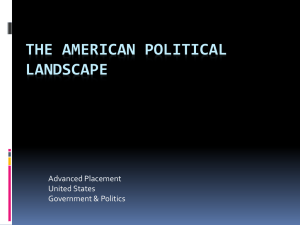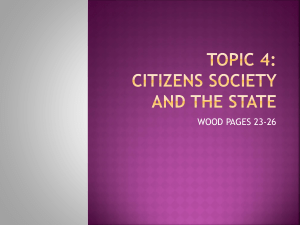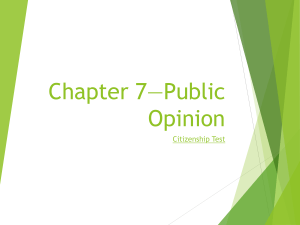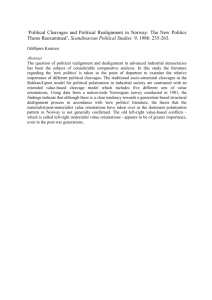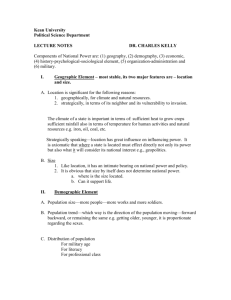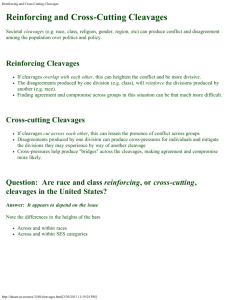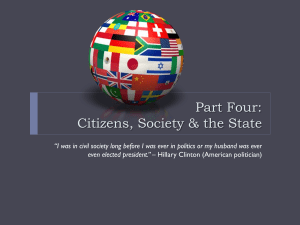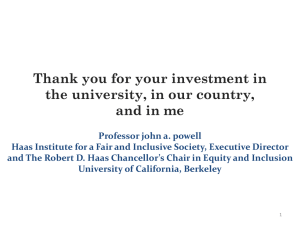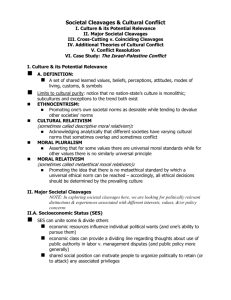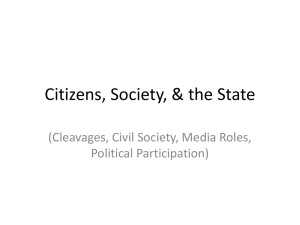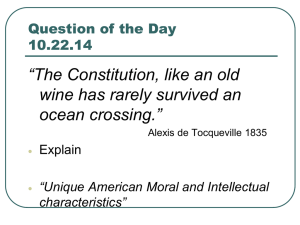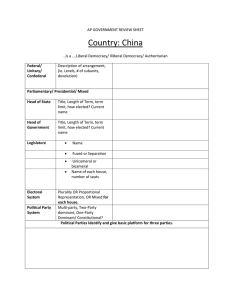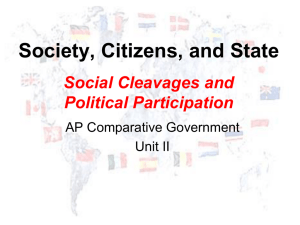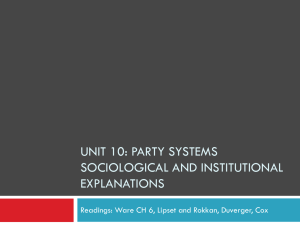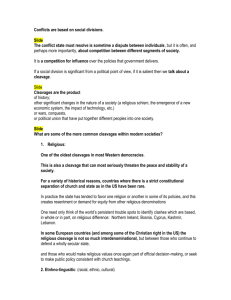Culture, Cleavages & Participation
advertisement
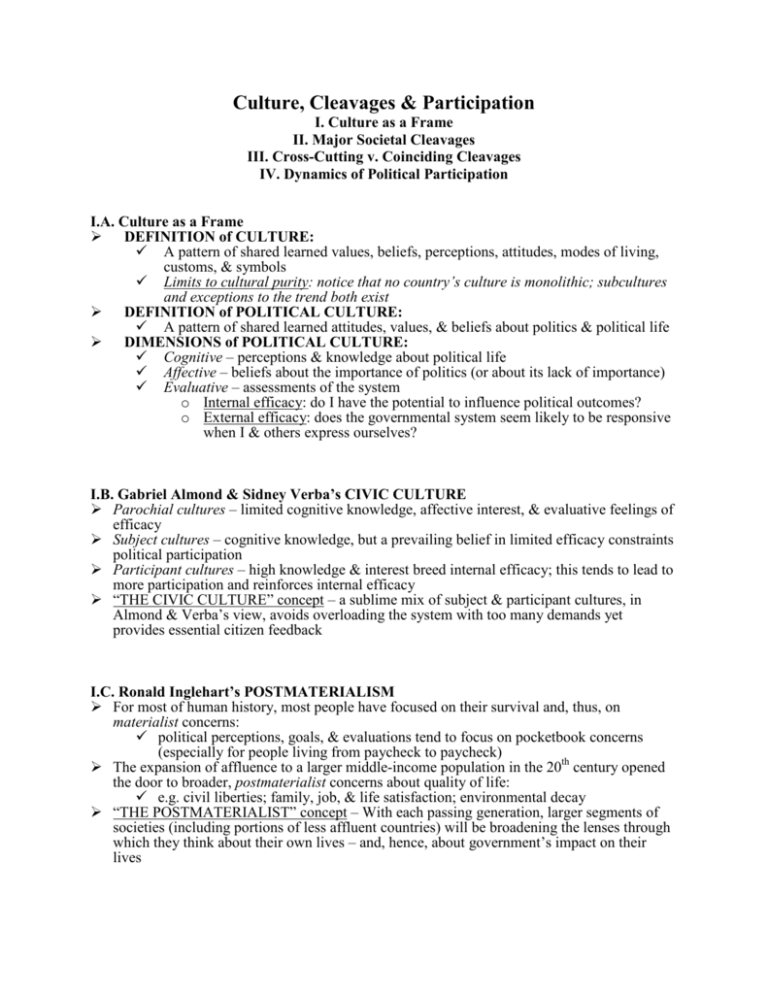
Culture, Cleavages & Participation I. Culture as a Frame II. Major Societal Cleavages III. Cross-Cutting v. Coinciding Cleavages IV. Dynamics of Political Participation I.A. Culture as a Frame DEFINITION of CULTURE: A pattern of shared learned values, beliefs, perceptions, attitudes, modes of living, customs, & symbols Limits to cultural purity: notice that no country’s culture is monolithic; subcultures and exceptions to the trend both exist DEFINITION of POLITICAL CULTURE: A pattern of shared learned attitudes, values, & beliefs about politics & political life DIMENSIONS of POLITICAL CULTURE: Cognitive – perceptions & knowledge about political life Affective – beliefs about the importance of politics (or about its lack of importance) Evaluative – assessments of the system o Internal efficacy: do I have the potential to influence political outcomes? o External efficacy: does the governmental system seem likely to be responsive when I & others express ourselves? I.B. Gabriel Almond & Sidney Verba’s CIVIC CULTURE Parochial cultures – limited cognitive knowledge, affective interest, & evaluative feelings of efficacy Subject cultures – cognitive knowledge, but a prevailing belief in limited efficacy constraints political participation Participant cultures – high knowledge & interest breed internal efficacy; this tends to lead to more participation and reinforces internal efficacy “THE CIVIC CULTURE” concept – a sublime mix of subject & participant cultures, in Almond & Verba’s view, avoids overloading the system with too many demands yet provides essential citizen feedback I.C. Ronald Inglehart’s POSTMATERIALISM For most of human history, most people have focused on their survival and, thus, on materialist concerns: political perceptions, goals, & evaluations tend to focus on pocketbook concerns (especially for people living from paycheck to paycheck) The expansion of affluence to a larger middle-income population in the 20th century opened the door to broader, postmaterialist concerns about quality of life: e.g. civil liberties; family, job, & life satisfaction; environmental decay “THE POSTMATERIALIST” concept – With each passing generation, larger segments of societies (including portions of less affluent countries) will be broadening the lenses through which they think about their own lives – and, hence, about government’s impact on their lives II. Major Societal Cleavages NOTE: In exploring societal cleavages here, we are looking for politically relevant distinctions & experiences associated with different interests, values, &/or policy concerns II.A. Socioeconomic Status (SES) SES can unite some & divide others economic resources influence individual political wants (and one’s ability to pursue them) economic class can provide a dividing line regarding thoughts about use of public authority in labor v. management disputes (and public policy more generally) shared social position can motivate people to organize politically to retain (or to attack) any associated privileges from the late 20th century forward, SES has been less central as a political cleavage than it had been for the first 80 years of the 20th century (per postmaterialism) o But, SES is still relevant II.B. Region A common subnational region can unite residents to mobilize to protect regional traditions to extract additional financial resources from the national government to gain greater political autonomy from the central government EXAMPLES? Northern League (Italy) Dixiecrats (U.S.) Scottish National Party (UK) various provincial parties in Brazil (and elsewhere in Latin America) Alliance for Democracy (Nigerian 4th Republic) II.C. Ethnicity A. Members of ethnic groups can develop a shared identity based on: common (presumed) racial ancestry common place of residence common language common customs & practices B. As we will discuss shortly, ethnicity becomes more powerful when members of certain ethnic groups are additionally united by a common position on some or many other cleavages: socioeconomic status, region, religion, ideology, etc. II.D. Religion Religion is a potentially all-encompassing belief system divine authority superior to all others in all realms by extension, deviation from those norms is heretical: o should not be tolerated → violates moral code o cannot be tolerated → toleration implies heresy Models of Church-State Relations Separation of Church & State o formal policies that aim at no entrenchment of religion e.g. U.S. (albeit amid underlying Judeo-Christian tradition) Hybrid model o freedom of religion & freedom of political authority from religious authority are combined with some/many policies that entrench &/or favor particular religions most countries in the world fit this profile Theocracy o leaders of organized religion have an institutionalized (& crucial) role in government e.g. the Islamic Republic of Iran established in 1979 II.E. Political Ideology Classical Liberalism PHILOSOPHICAL ANTHROPOLOGY o people are rational & have free will o people are naturally self-interested BASIC TENETS o political freedom → expansion of political participation o economic freedom → expansion of market’s role o emphasis on equality of opportunity rather than of outcomes Classical Marxism PHILOSOPHICAL ANTHROPOLOGY o people are rational o people’s self-interest is situational: class relations define people’s true interests BASIC TENETS o political & economic equality are the source of true freedom o emphasis on equality of outcome as basis of equality of opportunity III. Cross-Cutting v. Coinciding Cleavages cross-cutting cleavages cleavages that generally do not travel together coinciding (reinforcing) cleavages several/many cleavages travel together: o people from a certain region or ethnic group share similar SES, language, religion, and/or ideology When several cleavages coincide, sociopolitical tension and conflict tend to be greater than when cleavages tend to be cross-cutting… hypothetical examples of cleavage patterns NORTH south URBAN rural PROTESTANT Catholic AFFLUENT poor Largely cross-cutting Ethnic A Ethnic B 30% 70% 70% 30% 75% 65% 25% 35% 40% 50% 60% 50% 60% 45% 40% 55% Fully coinciding Ethnic A Ethnic B 100% 0% 100% 0% 100% 0% 100% 0% 0% 100% 0% 100% 0% 100% 0% 100% Demographic data on Israel & Palestine Gaza Strip Israel West Bank population 1.56m 7.23m 2.46m % Jewish 0% 75% 17% % Muslim 99% 17% 75% % urban 72% 92% 72% 16.0/1000 4.2/1000 18.4/1000 $28,400 $2,900 [avg. w/ Gaza] 40% 8% 19% 70% < $1. 08/day 23% < $7.30/day 46% < $1.08/day infant mortality GDP/capita [PPP] $2,900 [avg. w/ West Bank] unemployment poverty rate IV. Dynamics of Participation Forms of Political Participation CONVENTIONAL o voting o following politics in the news & in conversation o joining a political party or interest group o volunteering for parties & interest groups o campaigning o running for office UNCONVENTIONAL o consumer boycotts o street protests o strikes o civil disobedience o political violence Trends in Political Participation In wealthy countries o Voter turnout has declining in the long-running democracies in affluent countries since the 1970s…. o ….but other forms of political participation (both conventional & unconventional have been on the rise since the 1970s in those same countries (Table 9.1 in Newton & Van Deth, p.189) Most of that participation involves following & talking about politics Elsewhere, in middle-income & low-income countries o The proliferation of democratic and partially democratic regimes greatly expanded voter turnout in the 1970s and 1980s…. o …but voter turnout has been declining worldwide in the 21st century Causal Influences on Political Participation In general, you are more likely to participate if You had politically active parents Your socioeconomic status is higher Your level of education is higher Your income is higher You are also somewhat more likely to participate if Your age is between 35 and 65. You have resided in the same community for more than 10 years. You are male. You have are active in social & community groups.
